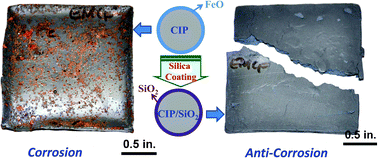Silica stabilized iron particles toward anti-corrosion magnetic polyurethane nanocomposites
Abstract
A sol–gel method is used to introduce fluorescent

* Corresponding authors
a
Integrated Composites Laboratory (ICL), Dan F. Smith Department of Chemical Engineering, Lamar University, Beaumont, TX, USA
E-mail:
zhanhu.guo@lamar.edu
Tel: (409) 880-7654
b Department of Chemistry and Biochemistry, Lamar University, Beaumont, TX, USA
c Aerospace Research Labs, Northrop Grumman Systems Corporation, Redondo Beach, CA, USA
d Department of Physics and Astronomy, Louisiana State University, Baton Rouge, LA, USA
e Microscopy and Imaging Center, Texas A&M University, College Station, TX, USA
A sol–gel method is used to introduce fluorescent

 Please wait while we load your content...
Something went wrong. Try again?
Please wait while we load your content...
Something went wrong. Try again?
J. Zhu, S. Wei, I. Y. Lee, S. Park, J. Willis, N. Haldolaarachchige, D. P. Young, Z. Luo and Z. Guo, RSC Adv., 2012, 2, 1136 DOI: 10.1039/C1RA00758K
To request permission to reproduce material from this article, please go to the Copyright Clearance Center request page.
If you are an author contributing to an RSC publication, you do not need to request permission provided correct acknowledgement is given.
If you are the author of this article, you do not need to request permission to reproduce figures and diagrams provided correct acknowledgement is given. If you want to reproduce the whole article in a third-party publication (excluding your thesis/dissertation for which permission is not required) please go to the Copyright Clearance Center request page.
Read more about how to correctly acknowledge RSC content.
 Fetching data from CrossRef.
Fetching data from CrossRef.
This may take some time to load.
Loading related content
